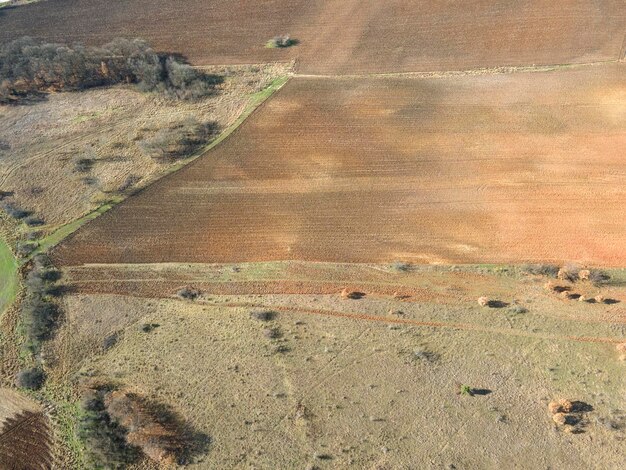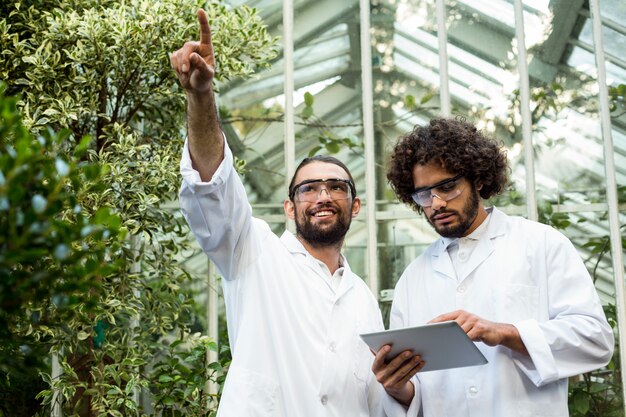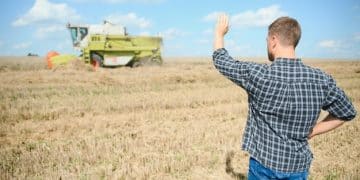Climate Change’s Impact on US Agriculture: What Farmers Need to Know

The evolving climate presents significant challenges and opportunities for US agriculture, necessitating adaptation in farming practices to ensure food security and economic resilience.
The landscape of American agriculture is shifting. From vast cornfields in the Midwest to citrus groves in Florida, the very foundation of US food production is grappling with an undeniable force: climate change. Understanding the impact of climate change on US agriculture: what farmers need to know is no longer an academic exercise but a pressing necessity for countless livelihoods and the nation’s food security.
Understanding the Shifting Climate Landscape for US Farmers
The climate has always influenced agriculture. Farmers plan their seasons based on historical weather patterns, but these patterns are no longer reliable. The observed changes are profound, affecting every aspect of farming, from planting schedules to crop yields. It’s a complex system where small shifts can have cascading effects.
Recent decades have shown a clear trend of rising temperatures across the United States. This isn’t just about warmer days; it means longer growing seasons in some regions but also intensified heat stress for crops and livestock in others. Precipitation patterns are also changing, leading to more frequent and severe droughts in some areas, while others experience increased heavy rainfall events and flooding.
Observable Climate Changes Directly Affecting Agriculture
- Increased frequency and intensity of extreme weather events, including heatwaves, droughts, and floods.
- Changes in seasonal temperatures, altering frost dates and growing season lengths.
- Shifts in precipitation patterns, leading to water scarcity or excess in different regions.
- Rising atmospheric CO2 levels, influencing plant growth and water use efficiency.
These climatic shifts translate into real-world challenges for farmers. For instance, an extended growing season might sound beneficial, but if it comes with prolonged heatwaves, it can negate any positive impact, leading to reduced yields or quality. Similarly, increased rainfall might be welcome, but if it falls in intense downpours, it can cause soil erosion and nutrient runoff, rendering it detrimental.
The scientific consensus highlights that these changes are largely driven by human activities, particularly the emission of greenhouse gases. For farmers, this means preparing for a future where historical averages are less useful and adaptability becomes paramount. Proactive strategies are essential to navigate these emerging conditions effectively.
Direct Threats: How Climate Change Impacts Crop Production
Climate change poses a multitude of direct threats to crop production, jeopardizing yield, quality, and the economic viability of farms. These impacts are varied and often interconnected, creating a complex web of challenges that farmers must confront.
One of the most immediate concerns is altered temperature regimes. Many staple crops, such as corn and soybeans, have specific temperature thresholds for optimal growth and reproduction. Elevated nighttime temperatures, for example, can disrupt key physiological processes, leading to lower grain fill and reduced yields. Heat stress can also accelerate crop maturity, resulting in smaller, less developed grains.
Specific Challenges for Major US Crops
Variations in temperature and precipitation directly affect the yields and quality of crops vital to the US economy and food supply. Understanding these crop-specific vulnerabilities is crucial for farmers.
- Corn: Highly susceptible to extreme heat during pollination, leading to significant yield reductions. Droughts during critical growth stages also severely impact production.
- Soybeans: While more heat-tolerant than corn, prolonged droughts and excessive heat still reduce seed size and oil content. Increased pest pressure is also a concern.
- Wheat: Spring wheat is vulnerable to heat stress during grain filling, while winter wheat is affected by unpredictable thaws and subsequent freezes that can damage plants.
- Specialty Crops (fruits, vegetables): These often have narrower optimal growing ranges and are highly sensitive to changes in temperature, chilling hours, and water availability, impacting quality and marketability.
Beyond temperature, changes in water availability are equally critical. Increasing drought frequency and severity in regions like the Southwest and parts of the Great Plains means reduced irrigation water or total crop failure for rain-fed systems. Conversely, increased heavy rainfall events, particularly in the Midwest and Northeast, can cause waterlogging, nutrient leaching, and exacerbate disease conditions, hindering crop establishment and development.
Pest and disease pressures are also evolving. Warmer winters may allow pests to survive in greater numbers and expand their geographic range. Shifting precipitation patterns can create more favorable conditions for fungal and bacterial diseases, requiring new management strategies and potentially increasing pesticide use. This multifaceted attack on crop production demands a holistic and adaptive approach from farmers.

Livestock Vulnerability and Adaptation Strategies
The impacts of climate change extend beyond crops, significantly affecting livestock health, productivity, and welfare. Ruminants, poultry, and other farm animals are susceptible to environmental stressors, necessitating new management practices.
Heat stress is a primary concern. Elevated temperatures, especially when combined with high humidity, can lead to reduced feed intake, lower growth rates, decreased milk production in dairy cattle, and impaired reproductive performance. In severe cases, heat stress can result in increased mortality rates, particularly in poultry and older animals. Farmers must invest in cooling systems, improved shade, and altered feeding schedules to mitigate these effects.
Key Climate Impacts on Livestock
- Heat Stress: Reduced feed intake, lower fertility, decreased milk/egg production, increased mortality.
- Water Scarcity: Reduced access to clean drinking water, leading to dehydration and stress.
- Forage Availability: Droughts reduce pasture and hay yields, increasing feed costs and reliance on supplemental feed.
- Disease Vector Expansion: Warmer climates allow disease-carrying insects (e.g., ticks, mosquitoes) to thrive and expand their range, introducing new health risks.
Beyond direct physiological impacts, climate change influences the availability and quality of feed resources. Droughts can decimate pastures and reduce hay yields, forcing farmers to purchase more expensive supplemental feed or reduce herd sizes. Changes in plant composition due to higher CO2 levels can also alter the nutritional value of forage, further challenging animal health.
Indirectly, altered climate patterns can expand the geographic range and seasonal activity of disease vectors like mosquitoes and ticks. This introduces new or increased risks from diseases such as West Nile virus, anaplasmosis, and Lyme disease, requiring enhanced biosecurity and veterinary care. Adapting livestock operations involves a combination of infrastructural improvements, genetic selection for more resilient breeds, and proactive health management to ensure animal welfare and sustainable production.
Water Resource Management in a Changing Climate
Water is the lifeblood of agriculture, and its availability is profoundly impacted by climate change. Farmers face the dual challenge of managing increasing water scarcity in some regions and dealing with excessive water in others, demanding innovative and efficient resource management strategies.
In many parts of the US, particularly the arid and semi-arid West, reliance on snowpack from mountain ranges for seasonal water supply is critical. Warmer temperatures are accelerating snowmelt, leading to earlier peak flows and reduced water availability later in the dry season when crops need it most. This forces difficult decisions about irrigation allocations and crop choices.
Advanced Water Conservation Techniques
To combat water scarcity, farmers are increasingly adopting technologies and practices that maximize water use efficiency and minimize waste.
- Precision Irrigation: Drip irrigation, micro-sprinklers, and sensor-based systems deliver water directly to the plant roots, reducing evaporation and runoff.
- Water Harvesting: Capturing and storing rainwater or runoff for later use, particularly in regions with episodic heavy rainfall.
- Drought-Tolerant Crops: Selecting crop varieties genetically adapted to withstand drier conditions, reducing reliance on irrigation.
- Soil Moisture Monitoring: Using sensors to determine exact water needs, preventing over-irrigation and optimizing scheduling.
Conversely, regions experiencing an increase in intense rainfall events grapple with water excess. This can lead to waterlogging of fields, which starves plant roots of oxygen, reduces nutrient uptake, and increases the risk of fungal diseases. Such events also contribute to significant soil erosion, washing away fertile topsoil and polluting waterways with agricultural runoff.
Effective water resource management also involves watershed-level planning, including reservoir management, groundwater recharge, and inter-state cooperation. Farmers are also exploring practices like conservation tillage and cover cropping, which improve soil health and its ability to absorb and retain water, making fields more resilient to both droughts and floods. The future of US agriculture heavily depends on judicious and adaptive water stewardship.
Soil Health and Biodiversity: Building Resilient Systems
Healthy soil is the foundation of productive agriculture, acting as a living ecosystem that supports plant growth. Climate change can degrade soil health through erosion, compaction, and loss of organic matter, but adopting practices that enhance soil biodiversity is key to building resilience.
Extreme weather events, such as intense rainfall, severely exacerbate soil erosion, leading to the loss of irreplaceable topsoil and valuable nutrients. Prolonged droughts can dry out soils, making them prone to wind erosion and reducing microbial activity essential for nutrient cycling. These processes diminish the soil’s capacity to support vigorous crop growth and retain water.
Practices for Enhancing Soil Resilience
Proactive management of soil health can mitigate the adverse effects of climate change, fostering more stable and productive agricultural systems.
- Cover Cropping: Planting non-cash crops between main harvesting seasons to protect soil from erosion, suppress weeds, and add organic matter.
- No-Till/Reduced Tillage: Minimizing soil disturbance helps maintain soil structure, increase organic carbon, and enhance water infiltration and retention.
- Crop Rotation: Diversifying crops over time improves soil fertility, breaks pest and disease cycles, and reduces reliance on synthetic inputs.
- Compost and Manure Application: Adding organic amendments enhances soil structure, microbial activity, and nutrient availability.
Beyond soil structure, biodiversity within agricultural landscapes is crucial. This includes the diversity of crops, livestock, and beneficial insects and microorganisms. Diverse ecosystems are inherently more resilient to shocks, whether from pests, diseases, or extreme weather. For example, maintaining natural habitats adjacent to fields can support pollinators and natural enemies of pests, reducing the need for chemical interventions.
Investing in soil health practices not only helps farmers adapt to climate change but can also contribute to climate change mitigation by sequestering carbon in the soil. These regenerative practices create a positive feedback loop: healthier soils lead to more resilient farms, which in turn are better equipped to withstand the pressures of a changing climate, ensuring long-term productivity and environmental stewardship.
Innovations and Adaptations: A Path Forward for US Farmers
The challenges presented by climate change are significant, but so are the opportunities for innovation and adaptation within US agriculture. Farmers are not merely victims of these changes; they are at the forefront of developing and implementing solutions.
Technological advancements play a crucial role. Precision agriculture, powered by GPS, sensors, and data analytics, allows farmers to apply inputs like water and fertilizer with unprecedented accuracy, reducing waste and maximizing efficiency. Remote sensing technologies can monitor crop health and identify stress points before they become critical, enabling timely interventions.

Key Adaptive Strategies and Technologies
Farmers are exploring and adopting a range of strategies to build resilience and maintain productivity in a changing climate.
- Climate-Resilient Crop Varieties: Developing and using varieties that are more tolerant to heat, drought, or specific pests and diseases.
- Diversified Farming Systems: Integrating livestock with crop production, implementing agroforestry, or growing a wider range of crops to spread risk.
- Seasonal Forecasting and Decision Support Tools: Using advanced meteorological data and computational models to make better-informed planting, harvesting, and input application decisions.
- Renewable Energy Integration: Installing solar panels or wind turbines on farms to reduce operational costs and carbon footprint.
Beyond technology, shifts in farm management practices are essential. This includes adjusting planting and harvesting dates to align with new temperature and precipitation patterns. For some, it might mean transitioning to entirely new crops or livestock breeds better suited to projections for their region’s future climate.
Collaboration and knowledge sharing are also vital. Farmers, researchers, extension services, and policymakers must work together to develop regional-specific adaptation strategies and provide the necessary support. Government programs and private initiatives can offer financial incentives for adopting climate-smart practices, ensuring that innovation reaches a broad base of agricultural producers. The path forward for US agriculture is one of continuous learning, strategic investment, and collective action to foster resilience in the face of inevitable change.
| Key Area | Brief Impact/Response |
|---|---|
| 📊 Crop Yields | Threatened by extreme heat, drought, and altered growing seasons. Requires resilient varieties. |
| 🐄 Livestock Health | Vulnerable to heat stress and changes in forage availability. Demands enhanced management. |
| 💧 Water Resources | 面临干旱和洪水加剧挑战。需要精准灌溉和蓄水。 |
| 🌱 Soil Health | Affected by erosion; improved via no-till, cover crops, and organic amendments for resilience. |
Frequently Asked Questions About Climate Change and US Agriculture
Climate change impacts crop yields through several mechanisms, including increased heat stress during critical growth stages, more frequent droughts reducing water availability, and unpredictable heavy rainfall leading to waterlogging and disease. These factors can collectively reduce overall productivity and quality of agricultural output.
Livestock farmers primarily face challenges from increased heat stress, diminished pasture quality due to drought, and potential expansion of disease vectors. These conditions can lead to reduced animal productivity, impaired reproduction, higher feed costs, and increased mortality rates among herds.
Effective water management involves adopting precision irrigation systems like drip irrigation, implementing soil moisture monitoring to optimize watering schedules, and utilizing water-harvesting techniques. Additionally, integrating drought-tolerant crop varieties and improving soil organic matter content can boost water retention, making farms more resilient to varying water availability.
Healthy soil is crucial for climate adaptation because it improves water infiltration and retention, reduces erosion, and enhances nutrient cycling. Practices like no-till farming, cover cropping, and adding organic matter build soil resilience, allowing it to better withstand extreme weather events and support consistent crop growth.
Innovations like climate-resilient crop varieties developed through breeding and genetic modification, precision agriculture technologies for optimized resource use, and advanced climate forecasting tools are crucial. Additionally, diversifying farming systems and integrating renewable energy sources contribute to building more adaptable and sustainable agricultural operations across the US.
Conclusion: Cultivating Resilience in a Changing Climate
The intricate relationship between climate change and US agriculture demands a proactive and adaptable approach from farmers and stakeholders alike. While the challenges are multifaceted, touching everything from crop yields and livestock health to water availability and soil integrity, the path forward is illuminated by innovation, sustainable practices, and collaborative efforts. By embracing advanced technologies, fostering soil health, efficiently managing water resources, and developing climate-resilient practices, American farmers can not only mitigate the adverse impacts but also cultivate a more resilient and sustainable agricultural future. The collective commitment to adapting and evolving will ensure the continued productivity and security of the nation’s food supply in the face of an ever-changing climate.





